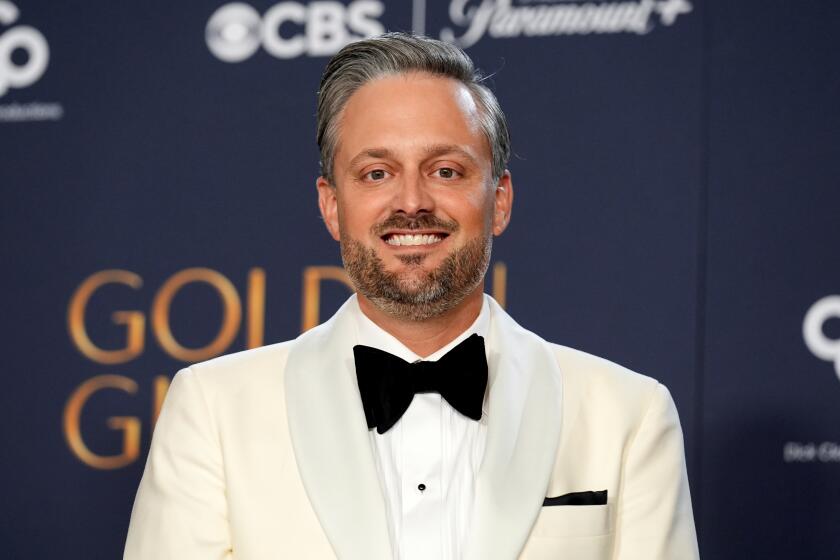Eight teams and 1,190 shots go into ‘Blade Runner 2049’s’ visual effects
- Share via
John Nelson recalls his first reaction when he was asked to be the visual effects supervisor for “Blade Runner 2049.” “I told them, ‘You’ve got to be ... kidding me!’ Ridley Scott’s original ‘Blade Runner’ is an important movie for anyone who loves sci-fi, visual effects and cinema in general. It’s also one of my favorites, so it only took about half a second for me to say, ‘Yes, I’m definitely interested!’”
Nelson, who along with Gerd Nefzer, Paul Lambert and Richard R. Hoover, is nominated for an Academy Award for his work on the movie, was fully aware that working on the “Blade Runner” sequel was not going to be an easy task.
“We all had a tremendous respect for the original 1982 film, but we all knew that we weren’t going to make the same movie again,” he says. “Fortunately, our director, Denis Villeneuve, rips every frame from his guts. It’s a deep-tissue, immersive experience and we had a dream team of great people pulling hard to make a worthy sequel.”
WATCH: Video Q&A’s from this season’s hottest contenders »
The Oscar-winning VFX supervisor (“The Gladiator”) led a team of artists and technicians at eight visual effects companies across seven places -- Vancouver; Montreal; London; Los Angeles; Prague, Czech Republic; Paris; New Zealand -- to deliver the film’s 1,190 visual effects shots.
“The movie is over two hours and 40 minutes long, and we have about an hour and 40 minutes of VFX shots,” he notes. “Every wide shot is a visual effects scene, but we tried to shoot as much of the film in-camera as possible.”
“Blade Runner 2049” takes place 31 years after the events of the first movie and centers on a troubled L.A. policeman named Agent K who is tasked with retiring rogue androids (replicants).
Nelson says one of the most challenging effects in the movie was “the merge,” a threesome sequence involving the holographic character Joi (Ana de Armas), the human character Mariette (Mackenzie Davis) and K (Gosling).
Villeneuve shot the two actresses separately, using multiple cameras around the room to record their movements from various angles. Then, each actress’ three-dimensional positioning was input to the computer frame by frame.
“We used this idea of a ‘back-facing shell,’” he says. “When you hold up a glass, you can see through the front of the glass to the back shell. We shot the actress, mapped on the CG object to her front, and then, generated the back shell. When she moved, those textures would rotate. It all led to this special moment when the two women’s eyes line up.”
The sequel also brings back Rachael, one of “Blade Runner’s” original replicants. The team at Montreal’s Moving Picture Co. used various techniques, including scanning actress Sean Young, 35 years after she originally played the character opposite Harrison Ford’s Rick Deckard. MPC created a digital stand-in and animated it using a motion-captured performance from another actress (Loren Peta).
“We shot a body double from the neck down and replaced it with a CG neck, head and hair, and we added the little blemishes on the skin, the fly-away hair for additional realism. I learned everything about ’80s makeup from the women in the crew.”
Once they had the physical looks of the digital Rachael down, Nelson and the team had to make sure she also acted like the original replicant.
“We went back to the original movie and saw how confident she was,” he says. “When she gets close to Harrison Ford’s character, we get this rush of emotion across her face, like two people who’ve been separated from each other and see each other in a train station. There’s this confidence, which turns into longing and then she is rejected. We looked at the moments when she went through the same emotions in ‘Blade Runner’ and tried to reverse engineer them in the new performance.”
It’s been quite satisfying to see his labor of love come to fruition and please the fans of the original movie, says Nelson. Witnessing audiences’ surprise when they see a younger version of Sean Young on the big screen has also been fun. “It’s funny, I was leaving a screening of the film and I heard this guy in front of me say, “Wow, Sean Young — man, she’s really been working out!”
More to Read
From the Oscars to the Emmys.
Get the Envelope newsletter for exclusive awards season coverage, behind-the-scenes stories from the Envelope podcast and columnist Glenn Whipp’s must-read analysis.
You may occasionally receive promotional content from the Los Angeles Times.






